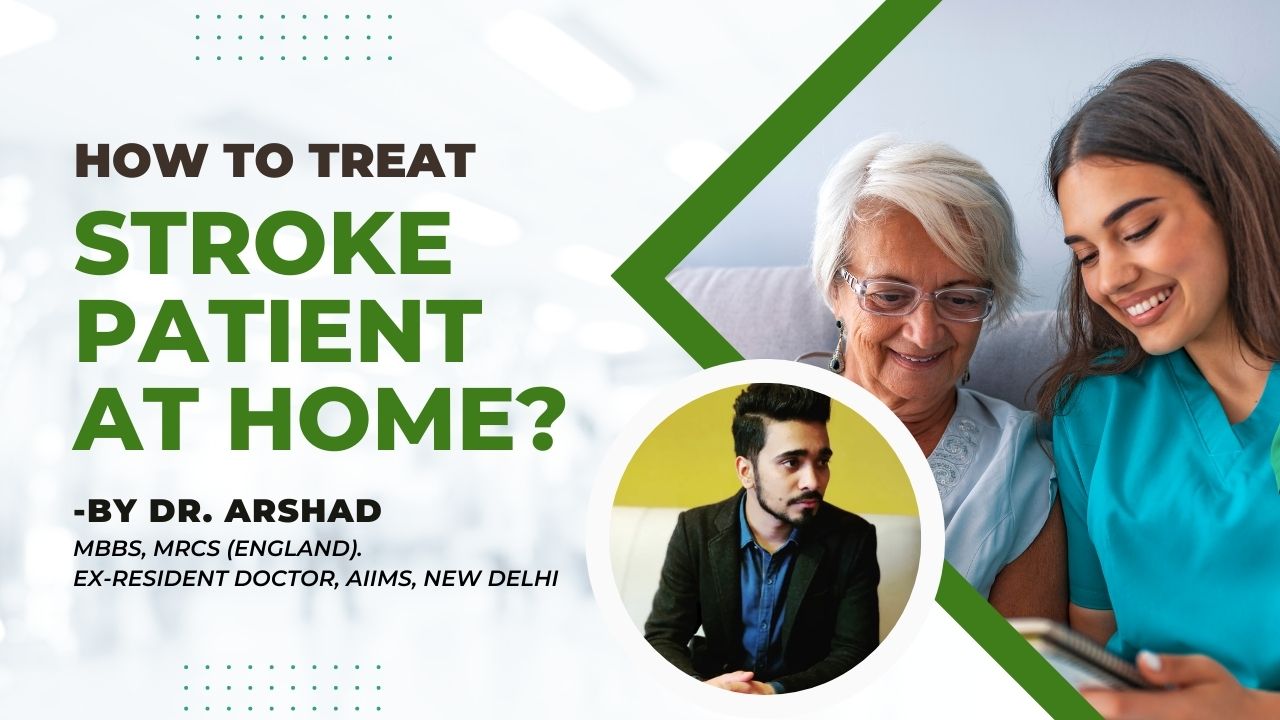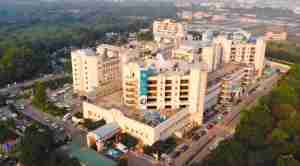Is someone you love recovering from a stroke? You might wonder how to treat or care for them at home. But it could feel overwhelming to figure out where to begin. So here’s how to treat stroke patient at home once your patient has been discharged from hospital.
In this article, I’ll explain how to manage stroke patients. These tips can help you address issues whether you are caring for yourself or someone else.
Besides the tips we will discuss in this article, having a healthcare professional on hand is essential for consultation. That’s why I offer online consultations for individuals who need them. Whether you have any concerns or want to know more about stroke prevention and treatment, I’m here to help.
What Is Stroke, and What Are Its Symptoms?
A stroke happens when a blockage prevents blood from reaching the brain. This causes brain cells to die because they do not receive the required oxygen and nutrition.
Two forms of stroke are:
- Ischemic stroke is due to a clot blocking the blood vessels in the brain.
- Hemorrhagic stroke occurs due to internal bleeding within the skull.
Some common symptoms of a stroke are:
- Numbness of body
- Loss of body balance
- Trouble in walking
- Dizziness
- Sudden confusion
- Severe headache with no known cause
How To Manage Stroke Patients At Home?
Stroke patients face many challenges but can regain functional independence with careful management. Whether you’re a family member or friend, providing the proper support can help them recover. The following are the best ways to manage stroke patients at home.
1. Follow Doctor’s Orders.
After a stroke, it’s essential to follow your doctor’s instructions. He will design a plan, including diet, exercise, medication, and follow-up visit dates. Ensure the patient follows all plans and visits the doctor’s follow-up plan. Keep notes about what the doctor discussed during appointments to remember critical instructions.
2. Provide Healthy Nutrition.
Healthy nutrition plays a significant role in promoting healing and preventing future problems. Ensure stroke survivors consume wholesome foods rich in vitamins and minerals. Low salt, sugar, and fat meals can support the patient’s recovery and health.
3. Assist With Daily Activities.
For stroke patients, it becomes challenging to live alone. Offer them help, from bathing and dressing to feeding and housekeeping tasks. Break larger duties into smaller steps to make life easier and reduce frustration. Consider investing in tools like shower seats or reachers to improve convenience.
4. Create A Safe Environment.
Reducing safety hazards helps prevent accidents and injuries. Remove obstacles and tripping hazards throughout your loved one’s living space. Make necessary modifies like handrails in bathrooms or wheelchair ramps if required. Maintain good lighting quality to promote indoor mobility. It could also benefit persons who struggle with vision issues following a stroke.
5. Encourage Physical Activity.
Engaging in exercises customized to one’s capacity contributes to improving function. Because exercise stimulates blood flow, reduces muscle stiffness, and enhances balance.
Build strength through low-impact workouts, range-of-motion exercises, and balance training. Consult with a qualified therapist to design a personalized physical therapy schedule.
6. Use Adaptive Devices.
Providing assistive devices to stroke patients is essential to post-stroke care and rehabilitation. These devices can help improve the patient’s mobility and quality of life. It also reduces the risk of injury.
Depending on the patient’s level of disability, you can use a range of assistive devices. Devices like canes, walkers, and crutches can help improve balance and stability. You can install grab bars and handrails in bathrooms to prevent falls. Wheelchair ramps and lifts are often used to ease access to different parts of the home.
7. Manage Medications.
Stroke patients need many drugs to manage different aspects of their condition. These include medicines for high blood pressure and cholesterol levels and blood thinners to prevent clots.
Managing these therapies requires careful oversight of medication administration times and strengths. In some cases, changes in medicines may be necessary based on the patient’s symptoms or response to treatment. Communicating any concerns or questions about medications to the patient’s doctor is important.
Contact health professionals whenever you notice worrisome symptoms or drug side effects. It’s crucial to remember to track all prescribed pharmaceuticals and doses.
8. Promote Communication Skills.
Language deficiencies resulting from stroke may cause social isolation and affect mental well-being. So must promote communication skills to avoid stress.
Active discussion is one excellent technique to improve communication abilities in stroke victims. You can do so by involving the patient in wordplay activities such as word puzzles and board games. These exercises can aid in the patient’s cognitive growth and linguistic development.
You should also consult a speech-language pathologist. He can help improve verbal expression abilities. Regular interaction between stroke survivors and others also encourages neurological improvements.
9. Address Depressive Symptoms.
As a doctor, I understand that recovery from a stroke can be emotionally taxing. It’s common for stroke patients to experience depressive symptoms. You may notice the following symptoms of depression in stroke patients;
- Sadness or hopelessness
- Interest in activities
- Changes in sleep patterns and appetite
- Fatigue and difficulty concentrating
- Thoughts of self-harm
It’s essential to recognize these signs and seek professional help if necessary.
Treatment for depression can include medication, therapy, or a combination of both. Psychotherapy can help patients to cope with depression. Providing emotional support and engaging in activities can also reduce the risk of depression.
Also, I offer online consultancy for stroke management, including depression management. If you or someone else is having depression after a stroke, please don’t hesitate to contact me for guidance.
10. Manage Bladder & Bowel Issues.
Changes in continence following a stroke need regular monitoring and strict hygiene practices. Establish a clean catheterization schedule based on medical guidance. If constipation arises due to reduced fluid intake, give patients high-fiber foods or supplements. Open communication around these sensitive topics supports rapid recovery.
11. Manage Pain.
Stroke patients may experience pain related to muscle weakness or nerve damage. Pain management strategies often include medicines and physical therapy. Follow these simple tips to manage pain at home;
- Track pain levels and report any changes to the healthcare team
- Follow the doctor’s instructions for medication use and dosage
- Explore non-pharmacological pain management options such as physical therapy, massage therapy, or acupuncture
- Provide a comfortable environment and support affected areas with pillows or cushions
- Encourage gentle exercise and movement
12. Manage Sleep Disturbances.
Insomnia or disrupted rest patterns often go with post-stroke recovery. Ensure to adjust the patient’s bedtime and waking hours. Follow these tips to manage sleep disturbances;
- Create a consistent bedtime routine.
- Ensure the sleeping environment is quiet, dark, and comfortable.
- Avoid caffeine and alcohol close to bedtime.
- Encourage regular exercise during the day.
- Consider relaxation tricks such as deep breathing or meditation.
- Discuss with the healthcare team if medication adjustments are necessary
- Track for sleep disorders that may need treatment
- Seek professional help if sleep disturbances persist.
13. Stay Connected.
Staying connected with patients helps maintain essential social connections for fulfilment and happiness.
Here are some advantages of staying connected for stroke patients:
- Reduces social isolation and depression
- Provides emotional support
- Improves quality of life
- Offers opportunities for social engagement and meaningful activities
- Enhances access to information and resources related to stroke recovery.
Follow these tips to stay connected with stroke patients;
- Encourage social activities such as joining a club or engaging in a hobby.
- Help with virtual or in-person meetings with family and friends.
- Identify support groups or other relevant resources.
- Encourage participation in group activities or educational courses.
Avoid Risk Factors that Can Result in Recurrent Stroke
Some important risk factors for stroke include high blood pressure, diabetes, high cholesterol, smoking, dyslipidemia, and a sedentary lifestyle. Avoiding these risk factors can reduce the chances of having a recurrent stroke. Let’s have a look at these factors in detail;
Manage High Blood Pressure:
High blood pressure is the most significant risk factor for stroke. Ensure that the blood of the stroke patient remains normal. Follow these tips to manage blood pressure;
- Take medications as prescribed by the doctor.
- Follow a healthy and nutritious diet like fruits, vegetables, and whole grains.
- Engage in regular physical activity.
- Check blood pressure and follow up with the doctor as recommended.
Manage Diabetes:
Diabetes increases the risk of stroke. Ensure that the blood sugar level of the stroke patient remains in the normal range.
Follow these tips to manage diabetes;
- Follow a healthy diet.
- Take medications as prescribed by your doctor.
- Check your blood sugar levels regularly.
- Engage in regular physical activity.
- Follow up with your doctor as recommended.
Avoid Smoking and Alcohol Consumption:
Smoking and alcohol consumption is another important risk factor for stroke. To avoid the risk of recurrent stroke, make sure that the patient does not smoke or drink. Talk to the doctor about smoking cessation programs or medicines that can help the patient to quit smoking.
Manage Dyslipidemia:
Dyslipidemia is high cholesterol levels that increase the risk of stroke. Ensure to follow these tips to manage dyslipidemia.
Follow a healthy and nutritious diet low in saturated and trans fats.
- Engage in regular physical activity.
- Take medications as prescribed by your doctor.
- Check your cholesterol levels regularly.
- Follow up with your doctor as recommended.
Avoid a Sedentary Lifestyle:
A sedentary lifestyle increases the risk of stroke and can make you prone to other diseases. Follow these tips to avoid a sedentary lifestyle;
- Engage in regular physical activity.
- Engage in walking, cycling, swimming, or other healthy activities.
Final Words!
In conclusion, strokes are medical emergencies that can damage the brain within minutes. Seeking immediate medical attention is a crucial step toward minimizing disability from strokes. But there are many ways to support recovery after a stroke at home. Some of them are; exercise, a healthy diet and managing sleep and depression.
Also, avoiding risk factors that can cause recurrent stroke is important. Common risk factors are high blood pressure, diabetes and smoking. It’s vital to seek professional help, such as through speech or occupational therapy.
Finally, contact me for online consultation services if you have questions about your stroke care plan. Remember, every moment counts when treating strokes! Take action today to protect yourself or those you love from the consequences of a stroke.
Have a Doubts? Book Online Consultancy.
If You are having any doubt then you can book a free online consultancy directly with me, and I will surely guide you. I am Dr. Arshad – MBBS, MRCS ( England ). Just let me know and I will do everything possible to solve your doubts or will guide you.




